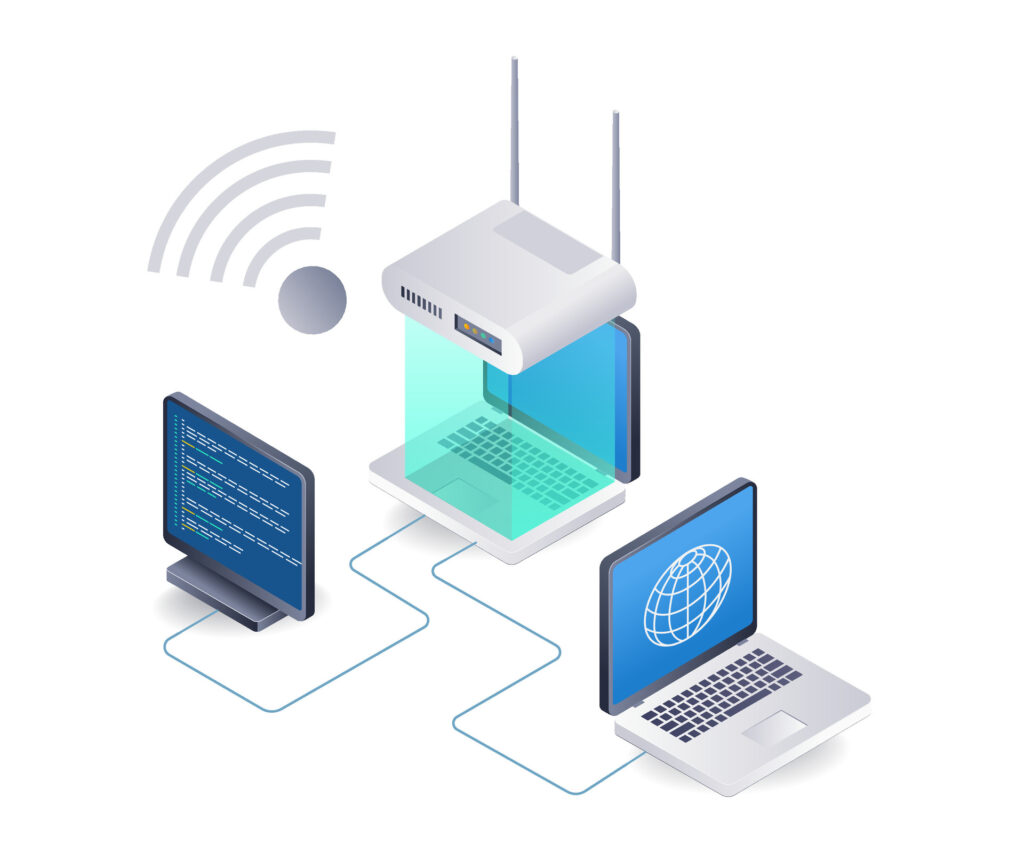Wireless Network Penetration Test

Trusted Cyber Security Experts
25+ Years Industry Experience
Ethical, Professional & Pragmatic
Wireless network penetration testing helps you identify security weaknesses that could provide attackers an easy way into your network from outside your organisation’s physical perimeter.
Wireless networks are widely used by laptops, printers, smartphones, tablets and IoT devices within organisations and can often be installed to cover general office space, meeting rooms, secure areas, reception spaces and even reach outside of your building into public spaces. Incorrectly configured wireless networks can put sensitive data at risk, as the data can sometimes be exposed to unauthorised devices or eavesdroppers who may be situated outside your physical office perimeter.
Targeted attacks against corporate wireless users are also on the rise, whereby attackers set up a rogue access point in an adjacent office or car park, in an attempt to coerce users into connecting to their malicious access point instead of the legitimate access point in their office space.
During one of our Wireless Network Penetration Tests our CREST accredited penetration testers will identify real-world vulnerabilities in your wireless network(s) that can be exploited by an attacker and provide you with advice on how your wireless network(s) can be better secured.

What types of vulnerabilities can a Wireless Network Penetration Test identify?
Conducting a targeted penetration test of your wireless Access Points (APs) and infrastructure provides you with an insight into the vulnerabilities that may be discovered and exploited by an attacker if they are within range of your WiFi networks. Some common vulnerabilities that we regularly find during wireless penetration testing include:
- Easily-guessable user credentials or Pre-Shared Keys (PSK)
- Lack of network segregation between wireless clients
- Poor isolation between adjacent wireless networks (SSIDs)
- Sensitive information exposure
- Weak wireless network traffic encryption
- Wireless clients susceptible to rogue wireless access points
- Unexpected or undocumented wireless devices
- Badly configured wireless network controller
Testing Process & Methodology
Depending on the types of wireless networks in use, our consultants will use a combination of automated and manual testing, with the goal of achieving network connectivity to your organisation’s wireless network(s) through vulnerabilities that may be present.
Our typical methodology for a Wireless Network Penetration Test includes attempting the following:
- Identifying weak encryption protocols
- Capturing authentication handshakes
- Cracking Pre-Shared Keys (PSK) to allow remote access
- Identifying rogue access points that may have been planted inside the organisation’s building(s)
- Authentication attacks between legitimate wireless devices and the organisations Access Points (APs)
- Identifying information disclosure when wireless clients connect to your network
- Certificate spoofing attacks
During the assessment, our consultancy team can deploy rogue wireless Access Points (APs) throughout your organisation, which will be used to try and coerce employees into connecting to them. In the event of a user connecting to one of these rogue access points, we can attempt to further the attack on the workstation and then potentially onto the corporate domain.
All penetration testing that we conduct is carried out in line with globally-recognised standards, such as the Penetration Testing Execution Standard (PTES) and the Open Source Security Testing Methodology Manual (OSSTMM). In addition to this, as a member of the Council of Registered Ethical Security Testers (CREST), we conduct our testing and consultancy to the highest, industry-recognised standards and ethics.
Preparing for your Wireless Penetration Test
- A signed & completed Testing Consent Form (TCF)
- List of wireless SSIDs to be tested
- If a WPA-Enterprise network is in scope of testing, we will need a corporate laptop or device that we can access with administrative rights in order to check the configuration.
- If a configuration review of your wireless controller is in scope, we will need the IP address of the controller and credentials that we can access it with. This can be a read-only account providing the account will allow us to inspect all areas of the wireless controller.
- If network segregation testing is to be performed, we will need the IP address ranges that you would like us to ensure are segregated from the wireless network(s).
Reporting
Our clear & concise penetration test reports enable everyone in your organisation to understand the vulnerabilities that have been identified and the real-world risk that your systems and data are exposed to. Our reports include:
- A “board-level friendly” Executive Summary
- Comprehensive, evidence-based vulnerability reporting
- Risk-based vulnerability ranking with CVSS Scoring
- Technical references and links for further research by your technical team
Debrief Call
Once you have received our final report, you have the option of attending a conference call between the consultant(s) involved in delivering your project and individuals within your organisation who you feel would benefit from a more in-depth discussion of the report’s findings.
After Care
Once our consultancy engagement is complete and our final report has been delivered to you, our consultancy team remain available to you indefinitely for any questions you may have surrounding the report’s findings or our consultancy engagement with you.
Why Choose SecureTeam?
- UK-based Consultancy Team
- Customer Focused
- Security Vetted Consultants
- Ethical Scoping & Pricing
- 25+ Years Industry Experience
- ISO 9001 & 27001 Certified
- CREST Accredited
- Comprehensive Reporting





Ready to take your cyber security to the next level ?
Trusted Cyber Security Experts
As an organisation, SecureTeam has provided penetration testing and cyber security consultancy to public & private sector organisations both in the United Kingdom and worldwide. We pride ourselves in taking a professional, pragmatic and customer-centric approach, delivering expert cyber security consultancy – on time and within budget – regardless of the size of your organisation.
Our customer base ranges from small tech start-ups through to large multi-national organisations across nearly every sector – in nearly every continent. Some of the organisation’s who have trusted SecureTeam as their cyber security partner include:










Customer Testimonials

"Within a very tight timescale, SecureTeam managed to deliver a highly professional service efficiently. The team helped the process with regular updates and escalation where necessary. Would highly recommend"
IoT Solutions Group Limited Chief Technology Officer (CTO) & Founder
“First class service as ever. We learn something new each year! Thank you to all your team.”
Royal Haskoning DHV Service Delivery Manager
“We’ve worked with SecureTeam for a few years to conduct our testing. The team make it easy to deal with them; they are attentive and explain detailed reports in a jargon-free way that allows the less technical people to understand. I wouldn’t work with anyone else for our cyber security.”
Capital Asset Management Head of Operations
“SecureTeam provided Derbyshire's Education Data Hub with an approachable and professional service to ensure our schools were able to successfully certify for Cyber Essentials. The team provided a smooth end-to-end service and were always on hand to offer advice when necessary.”
Derbyshire County Council Team Manager Education Data Hub
“A very efficient, professional, and friendly delivery of our testing and the results. You delivered exactly what we asked for in the timeframe we needed it, while maintaining quality and integrity. A great job, done well.”
AMX Solutions IT Project Officer
“We were very pleased with the work and report provided. It was easy to translate the provided details into some actionable tasks on our end so that was great. We always appreciate the ongoing support.”
Innovez Ltd Support Officer
"SecureTeam have provided penetration testing for our system since 2021, and I cannot recommend them enough. The service is efficient & professional, and the team are fantastic to work with; always extremely helpful, friendly, and accommodating."
Lexxika Commercial DirectorGet in touch today
If you’d like to see how SecureTeam can take your cybersecurity posture to the next level, we’d love to hear from you, learn about your requirements and then send you a free quotation for our services.
Our customers love our fast-turnaround, “no-nonsense” quotations – not to mention that we hate high-pressure sales tactics as much as you do.
We know that every organisation is unique, so our detailed scoping process ensures that we provide you with an accurate quotation for our services, which we trust you’ll find highly competitive.
Get in touch with us today and a member of our team will be in touch to provide you with a quotation.
Subscribe to our monthly newsletter today
If you’d like to stay up-to-date with the latest cyber security news and articles from our technical team, you can sign up to our monthly newsletter.
We hate spam as much as you do, so we promise not to bombard you with emails. We’ll send you a single, curated email each month that contains all of our cyber security news and articles for that month.

“We were very impressed with the service, I will say, the vulnerability found was one our previous organisation had not picked up, which does make you wonder if anything else was missed.”
Aim Ltd Chief Technology Officer (CTO)